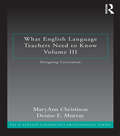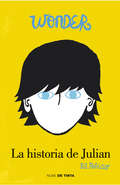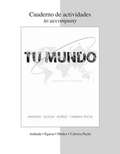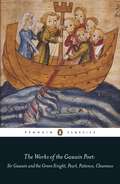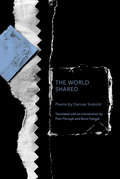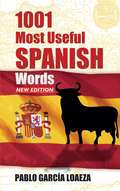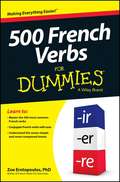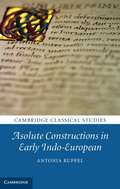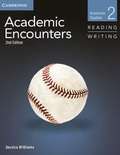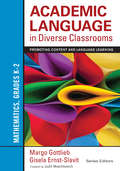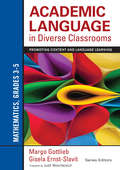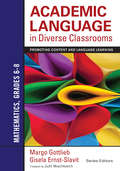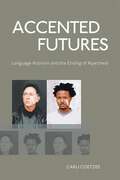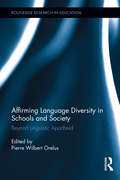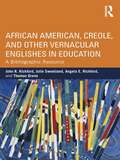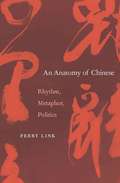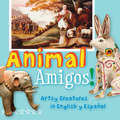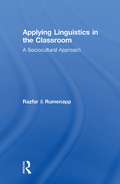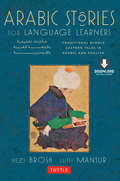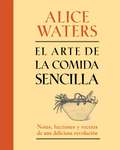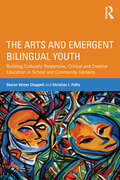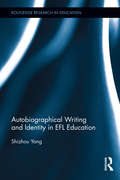- Table View
- List View
What English Language Teachers Need to Know Volume III: Designing Curriculum
by MaryAnn Christison Denise E. MurrayWhat English Teachers Need to Know, a set of companion texts designed for pre-service teachers and teachers new to the field of ELT, addresses the key question: What do English language teachers need to know and be able to do in order for their students to learn English? These texts work for teachers across different contexts (countries where English is the dominant language, one of the official languages, or taught as a foreign language); different levels (elementary/primary, secondary, college or university, or adult education); and different learning purposes (general English, workplace English, English for academic purposes, or English for specific purposes). Volume I, on understanding learning, provides the background information that teachers need to know and be able to use in their classroom. Volume II, on facilitating learning, covers the three main facets of teaching: planning, instructing, and assessing. Volume III, on designing curriculum, covers the contexts for, processes in, and types of ELT curricula—linguistic based, content-based, learner-centered, and learning-centered. Throughout the three volumes, the focus is on outcomes, that is, student learning. Features • Situated in current research in the field of English language teaching and other disciplines that inform it • Sample data, including classroom vignettes • Three kinds of activities/tasks: Reflect, Explore, and Expand
Wonder. La historia de Julian
by R. J. PalacioWonder. La lección de August ha recordado a miles de lectores la importancia de ser amable. Pero este no es un libro sobre August, un niño que quiere ser normal a pesar de su aspecto, sino sobre Julian. ¿Qué motivos tiene Julian para odiar a August?¿Será capaz de asumir sus errores y empezar de nuevo? Wonder. La historia de Julian trata sobre el niño que peor se porta con Auggie. No soporta verlo, no soporta que sea amigo de Jack, no soporta que esté en su colegio... y no es capaz de darse cuenta del impacto que sus actos pueden tener en los demás. Provocadora, sorprendente y emotiva, Wonder. La historia de Julian deleitará a los lectores de Wonder. La lección de August... y a los que todavía no la han leído.
Workbook Lab Manual: Tu Mundo Actividades
by Magdalena Andrade Jeanne Egasse Elías Miguel Muñoz María Cabrera-PucheThe Cuaderno de actividades (Workbook/Laboratory Manual) to accompany Tu mundo links culture to the main text and to students' lives.
The Works of the Gawain Poet: Sir Gawain and the Green Knight, Pearl, Cleanness, Patience
by Ad Putter Myra StokesA new volume of the works of the Gawain poet, destined to become the definitive edition for students and scholars.This volume brings together four works of the unknown fourteenth-century poet famous for the Arthurian romance Sir Gawain and the Green Knight, in their original Middle English. In one of the great tales of medieval literature, Gawain, the noblest knight of King Arthur's court, must keep a deadly bargain with a monstrous knight and resist the advances of his host's beautiful wife. The dream vision of Pearl depicts a bereaved father whose lost child leads him to glimpse heaven. And in moral poems based on stories from the Bible, Cleanness warns against sins of the flesh and of desecration, while Patience encourages readers to endure suffering as God's will.Little is known about the so-called 'Gawain poet', who wrote during the late fourteenth century. It is believed that he came from south-east Cheshire, an important cultural and economic centre at the time, and he was clearly well-read in Latin, French and English. Although he is not named as the author of Sir Gawain and the Green Knight, Pearl, Patience, Cleanness, the four works have been attributed to him based on a careful comparison of their language, date and themes.Myra Stokes was formerly Senior Lecturer in the Department of English at Bristol University. Her books include Justice and Mercy in Piers Plowman and The Language of Jane Austen.Ad Putter teaches at the English Department and the Centre for Medieval Studies of the University of Bristol, where is Professor of Medieval English Literature. His monographs include Sir Gawain and the Green Knight and French Arthurian Romance and An Introduction to the Gawain Poet, and he is also co-editor of The Cambridge Companion to the Arthurian Legend.
The World Shared (Lannan Translations Selection Series)
by Dariusz SosnickiDariusz Sosnicki's poems open our eyes to the sublime just beneath the surface of the mundane: a train carrying children away from their parents for summer vacation turns into a ravenous monster; a meal at a Chinese restaurant inspires a surreal journey through the zodiac; a malfunctioning printer is a reminder of the ghosts that haunt us no matter where we find ourselves.Among the perpetrators and victims,buzzed or wasted to the bone,gliding without their blinkers onin the ruts of the national fate—they're not at home.Dariusz Sosnicki is an award-winning poet, essayist, and editor in Poland.
Schottenfreude: German Words for the Human Condition
by Ben SchottSchottenfreude is a unique, must-have dictionary, complete with newly coined words that explore the idiosyncrasies of life as only the German language can.Ever thought, There should be a German word for that? Well, thanks to the brilliantly original mind behind Schott&’s Original Miscellany, now there is. In what other language but German could you construct le mot juste for a secret love of bad foods, the inability to remember jokes, Sunday-afternoon depression, the urge to yawn, the glee of gossip, reassuring your hairdresser, delight at the changing of the seasons, the urge to hoard, or the ineffable pleasure of a cold pillow? A beguiling, ideal gift book for the Gelehrte or anyone on your list—just beware of rapidly expanding (and potentially incomprehensible) vocabularies.
1001 Most Useful Spanish Words NEW EDITION
by Dr Pablo Garcia LoaezaThis slim travel companion and at-home reference features 1,001 common words, each accompanied by a brief definition, a sentence demonstrating proper usage, and a translation. Up-to-date entries cover modern technology and consumer electronics, and a categorized section offers a convenient quick reference for words related to the family, the days of the week, and the seasons. Helpful tips on usage explain some of the finer points of vocabulary and grammar.
500 French Verbs For Dummies
by ErotopoulosVexed by French verbs? Fear no more!In 500 French Verbs For Dummies, beginning French language learners can find a quick reference for verbs in the basic present tenses. More advanced French speakers can utilize this book to learn more complex verb tenses and conjugations as well as advanced verbs with irregular endings. One page for each of the 500 most commonly used verbs in the French language --alphabetically arranged and numbered for easy referenceSpecial designation of the 50 most essential French verbsA summary of basic French grammar that includes verb tenses and moodsAn explanation of verb conjugation--the seven simple and seven compound tenses, as well as the imperativeThe accompanying CD-ROM includes flash cards and multiple choice questions with audio for practicing French verb conjugations and pronunciation500 French Verbs For Dummies is beneficial for students, travelers, professionals, and life-long learners who need a reference to the intricacies of French verb usage.
Absolute Constructions in Early Indo-European
by Antonia RuppelIn the past, discussions of absolute constructions (ACs) have been limited by an imprecise understanding of what ACs are. By examining the nature and function of ACs and related constructions in Greek, Latin and Sanskrit, this new study arrives at a clear and simple definition of ACs. Focussing on the earliest attested material in each language, it highlights how AC usage differs between languages and offers explanations for these differences. Identifying the common core shared by all ACs, it suggests a starting-point and way by which they developed into Greek, Latin and Sanskrit. Further historical study reveals how ACs have been conceived of by grammarians, philologists and even Christian missionaries over the last two thousand years and how enduring misconceptions still affect our discussion of them today. All Sanskrit material is annotated in detail, making it accessible for classicists in particular and allowing a better understanding of ACs in Greek and Latin.
Academic Encounters Reading Writing: American Studies
by Janis P. MeekTopics include the foundations of government, equal rights, and the American Dream. Students develop important skills such as skimming, reading for the main idea, reading for speed, understanding vocabulary in context, summarizing, and note-taking. By completing writing assignments, students build academic writing skills and incorporate what they have learned.
Academic Language in Diverse Classrooms: Promoting Content and Language Learning
by Dr Margo Gottlieb Gisela Ernst-SlavitMake every student fluent in the language of learning. The Common Core and ELD standards provide pathways to academic success through academic language. Using an integrated Curricular Framework, districts, schools and professional learning communities can: Design and implement thematic units for learning Draw from content and language standards to set targets for all students Examine standards-centered materials for academic language Collaborate in planning instruction and assessment within and across lessons Consider linguistic and cultural resources of the students Create differentiated content and language objectives Delve deeply into instructional strategies involving academic language Reflect on teaching and learning
Academic Language in Diverse Classrooms: Promoting Content and Language Learning
by Dr Margo Gottlieb Gisela Ernst-SlavitMake every student fluent in the language of learning. The Common Core and ELD standards provide pathways to academic success through academic language. Using an integrated Curricular Framework, districts, schools and professional learning communities can: Design and implement thematic units for learning Draw from content and language standards to set targets for all students Examine standards-centered materials for academic language Collaborate in planning instruction and assessment within and across lessons Consider linguistic and cultural resources of the students Create differentiated content and language objectives Delve deeply into instructional strategies involving academic language Reflect on teaching and learning
Academic Language in Diverse Classrooms: Promoting Content and Language Learning
by Dr Margo Gottlieb Gisela Ernst-SlavitMake every student fluent in the language of learning. The Common Core and ELD standards provide pathways to academic success through academic language. Using an integrated Curricular Framework, districts, schools and professional learning communities can: Design and implement thematic units for learning Draw from content and language standards to set targets for all students Examine standards-centered materials for academic language Collaborate in planning instruction and assessment within and across lessons Consider linguistic and cultural resources of the students Create differentiated content and language objectives Delve deeply into instructional strategies involving academic language Reflect on teaching and learning
Accented Futures: Language activism and the ending of apartheid
by Carli CoetzeeIn this wonderfully original, intensely personal yet deeply analytical work, Carli Coetzee argues that difference and disagreement can be forms of activism to bring about social change, inside and outside the teaching environment. Since it is not the student alone who needs to be transformed, she proposes a model of teaching that is insistent on the teacher?s scholarship as a tool for hearing the many voices and accents in the South African classroom. For Coetzee, ?accentedness? is a description for actively working towards the ending of apartheid by being aware of the legacies of the past, without attempting to empty out or gloss over the conflicts and violence that may exist under the surface. In the broad context of education, ?accent? can be an accent of speech; an attitude; a stance against being ?understood?; yet a way of teaching that requires teacher and pupil to understand each other?s contexts. This is a book about the relationships created by the use of language to convey knowledge, particularly in translation. The ideas it presents are evocative, thought-provoking and challenging at times. Accented Futures makes a significant and important contribution to research on identity in post-apartheid South Africa as well as to the fields of education and translation studies.
Affirming Language Diversity in Schools and Society: Beyond Linguistic Apartheid (Routledge Research in Education)
by Pierre Wilbert OrelusLanguage is perhaps the most common issue that surfaces in debates over school reform, and plays a vital role in virtually everything we are involved. This edited volume explores linguistic apartheid, or the disappearance of certain languages through cultural genocide by dominant European colonizers and American neoconservative groups. These groups have historically imposed hegemonic languages, such as English and French, on colonized people at the expense of the native languages of the latter. The book traces this form of apartheid from the colonial era to the English-only movement in the United States, and proposes alternative ways to counter linguistic apartheid that minority groups and students have faced in schools and society at large. Contributors to this volume provide a historical overview of the way many languages labeled as inferior, minority, or simply savage have been attacked and pushed to the margins, discriminating against and attempting to silence the voice of those who spoke and continue to speak these languages. Further, they demonstrate the way and the extent to which such actions have affected the cultural life, learning process, identity, and the subjective and material conditions of linguistically and historically marginalized groups, including students.
African American, Creole, and Other Vernacular Englishes in Education: A Bibliographic Resource (NCTE-Routledge Research Series)
by John R. Rickford Julie Sweetland Angela E. Rickford Thomas GranoMore than 50 years of scholarly attention to the intersection of language and education have resulted in a rich body of literature on the role of vernacular language varieties in the classroom. This field of work can be bewildering in its size and variety, drawing as it does on the diverse methods, theories, and research paradigms of fields such as sociolinguistics, applied linguistics, psychology, and education. Compiling most of the publications from the past half century that deal with this critical topic, this volume includes more than 1600 references (books, articles in journals or books, and web-accessible dissertations and other works) on education in relation to African American Vernacular English [AAVE], English-based pidgins and creoles, Latina/o English, Native American English, and other English vernaculars such as Appalachian English in the United States and Aboriginal English in Australia), with accompanying abstracts for approximately a third of them. This comprehensive bibliography provides a tool useful for those interested in the complex issue of how knowledge about language variation can be used to more effectively teach students who speak a nonstandard or stigmatized language variety.
An Anatomy of Chinese
by Perry LinkRhythms, conceptual metaphors, and political language convey meanings of which Chinese speakers themselves may not be aware. Link’s Anatomy of Chinese contributes to the debate over whether language shapes thought or vice versa, and its comparison of English with Chinese lends support to theories that locate the origins of language in the brain.
The Ancient Egyptian Language
by James P. AllenThis book, the first of its kind, examines how the phonology and grammar of the ancient Egyptian language changed over more than three thousand years of its history, from the first appearance of written documents, c. 3250 BC, to the Coptic dialects of the second century AD and later. Part One discusses phonology, working backward from the vowels and consonants of Coptic to those that can be deduced for earlier stages of the language. Part Two is devoted to grammar, including both basic components such as nouns and the complex history of the verbal system. The book thus provides both a synchronic description of the five major historical stages of ancient Egyptian and a diachronic analysis of their development and relationship.
Animal Amigos!
by San Antonio Museum of ArtWhat better way to learn animal names than with eye-catching works of art. With work from across Latin America and beyond, children will become armchair world travelers and art connoisseurs. This bilingual edition introduces early readers, and earlier listeners, to animals in both English and Spanish.
Applying Linguistics in the Classroom: A Sociocultural Approach
by Aria Razfar Joseph C. RumenappMaking linguistics accessible and relevant to all teachers, this text looks at language issues in the classroom through an applied sociocultural perspective focused on how language functions in society and in schools—how it is used, for what purposes, and how teachers can understand their students’ language practices. While touching on the key structural aspects of language (phonetics, phonology, morphology, and syntax), it does not simply give an overview, but rather provides a way to study and talk about language. Each chapter includes practical steps and suggests tools for applying different kinds of linguistic knowledge in classrooms. The activities and exercises are adaptable to elementary or high school settings. Many examples focus on the intersection of math, science, and language. Teacher case studies show how real teachers have used these concepts to inform teaching practices. Given the increasing use of multimedia resources in today’s schools, multiple mediums are integrated to engage educators in learning about language. The Companion Website provides a multitude of relevant resources that illustrate the diversity of language functions and debates about language in society.
Arabic Stories for Language Learners
by Hezi Brosh Lutfi MansurArabic Stories for Language Learners--a language learning experience for beginner to intermediate students.The traditional stories of a country are invaluable at providing insight into understanding the culture, history and language of a people. The sixty-six stories found in Arabic Stories for Language Learners present the vocabulary and grammar used everyday in Arabic-speaking countries. Pulled from a wide variety of sources that have been edited and simplified for learning purposes, these stories are presented in parallel Arabic and English, facilitating language learning in the classroom and via self-study. Each story is followed by a series of questions in Arabic and English to test comprehension and encourage discussion.Arabic Stories for Language Learners brings Arab culture to life in a colorful and immediate way. Regardless of whether or not you have a working knowledge of Arabic, this book gives readers a tantalizing introduction to the wisdom and humor of these ancient desert-dwelling peoples. An audio CD in Arabic and English helps students of Arabic improve their pronunciation and inflection, and immerses non-students into the uniquely Arabic storytelling style.
Arma, tiro, bammm!
by Joan Mari Irigoien Aranberri?Hamzak, beraz, leherketa hura zuen jada buruan: izango ez zuen, bada, puntuari begira zegoela musika hura etorri bazitzaion, bamm bamm-bamm? musika hura, bai, gorputzean ere sentitzen zuena, bere gorputza zuhaitz bat balitz bezala, zainak adartzat zituena eta bere bihotz hura fruitutzat; bihotz hura, soka bakarreko lautak bezala, bamm-bamm-bamm egiten zuena, sistoleak eta diastoleak bat eginik; musika hura, segundo gutiren buruan erabateko bakera eraman zuena: BAMMM!? Hari bi nobela bakar berean: batetik, Bereibarko familia bat (Gipuzkoa eta Bizkaia arteko alegiazko herria) bizibidez eskopeta-lantegi bat daukana; bestetik, Balad al Xams-eko (Ekialde Hurbileko balizko herrialdea) beste familia bat, gerra ahaztu baten ondorioak nozitu beharko dituena; modu paraleloan kontatzen zaizkigu batzuen nahiz besteen pozak eta nekeak, eguneroko kontu xeheak eta Historia markatzen duten gertakari handiak, XX. mendeko bigarren erdian hasi eta gaur arte. Hari biek, halabeharrez, bat egiten duten arte. Ez da ohikoa arma trafikoa gaitzat hartzea eleberri batean; irakurlearen gogo-bihotzak inarrosteko asmo osoz egin du Joan Mari Irigoienek, eta helburu horri begira erabili bere artearen tresna guztiak. Hiru ezaugarriok nabarmendu daitezke egilearen lanean: hizkuntzaren erabilera zaindu eta ederra, hainbat istorio sortu eta kateatzeko fabulazio-ahalmen itzela, eta gure gizarteko gai minberak ukitzeko kontzientzia etikoa.
El arte de la cocina sencilla
by Alice WatersDurante más de cuatro décadas, Alice Waters ha sido la máxima defensora de los alimentos locales de temporada producidos de forma sostenible. Ha sido aclamada globalmente y ha mostrado al mundo que el verdadero secreto de la buena cocina es comenzar con los ingredientes de mejor sabor. En El arte de la comida sencilla, Alice Waters aplica esta filosofía a 19 lecciones de cocina y a más de 250 recetas cotidianas que ilustran lo fácil que es comer maravi-llosamente bien si se cocina, se come y se vive según estas leyes fundamentales: Comer alimentos locales y sostenibles Comer alimentos de temporada Comprar en los mercados agrícolas Sembrar un jardín Conservación, compostaje y reciclaje Cocinar con simpleza Cocinar juntos Comer juntos Recordar que la comida es preciosa (Spanish translation of "The Art of Simple Food")
The Arts and Emergent Bilingual Youth: Building Culturally Responsive, Critical and Creative Education in School and Community Contexts
by Christian J. Faltis Sharon Verner ChappellThe Arts and Emergent Bilingual Youth offers a critical sociopolitical perspective on working with emerging bilingual youth at the intersection of the arts and language learning. Utilizing research from both arts and language education to explore the ways they work in tandem to contribute to emergent bilingual students’ language and academic development, the book analyzes model arts projects to raise questions about “best practices” for and with marginalized bilingual young people, in terms of relevance to their languages, cultures, and communities as they envision better worlds. A central assumption is that the arts can be especially valuable for contributing to English learning by enabling learners to experience ideas, patterns, and relationship (form) in ways that lead to new knowledge (content). Each chapter features vignettes showcasing current projects with ELL populations both in and out of school and visual art pieces and poems, to prompt reflection on key issues and relevant concepts and theories in the arts and language learning. Taking a stance about language and culture in English learners’ lives, this book shows the intimate connections among art, narrative, and resistance for addressing topics of social injustice.
Autobiographical Writing and Identity in EFL Education (Routledge Research in Education #97)
by Shizhou YangThe book explores the pedagogical potential of autobiographical writing in English-as-a-foreign language, approaching the topic from an educational, longitudinal, dialogical, and social perspective. Through a number of case studies, the author delineates four phases that EFL writers may experience in their identity construction processes, illustrating the complexity of EFL writers’ social identities. This book will provide a valuable resource for language teachers and researchers interested in the pedagogical applications of autobiographical writing.
